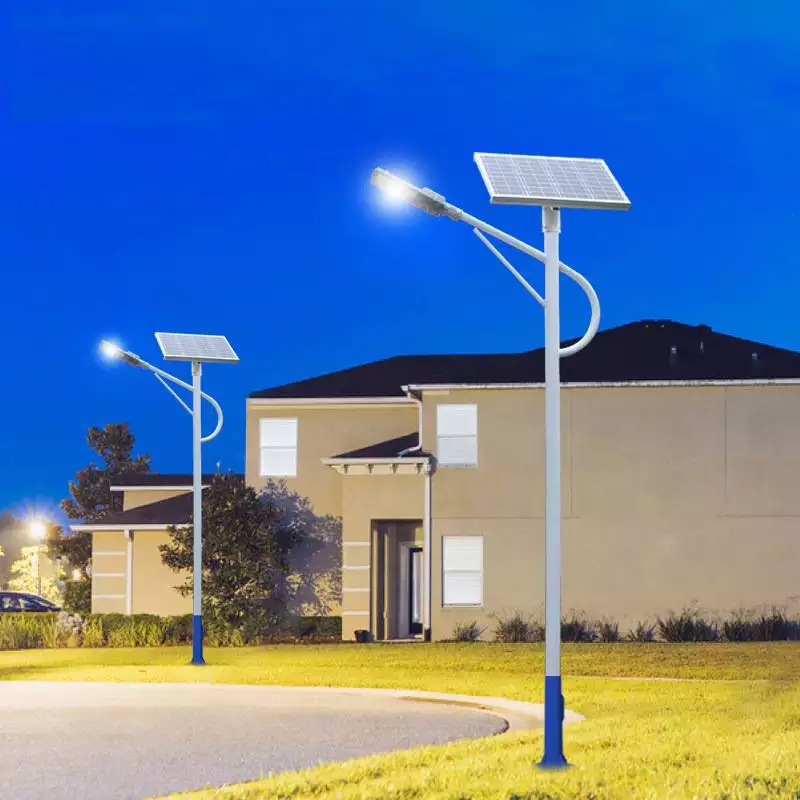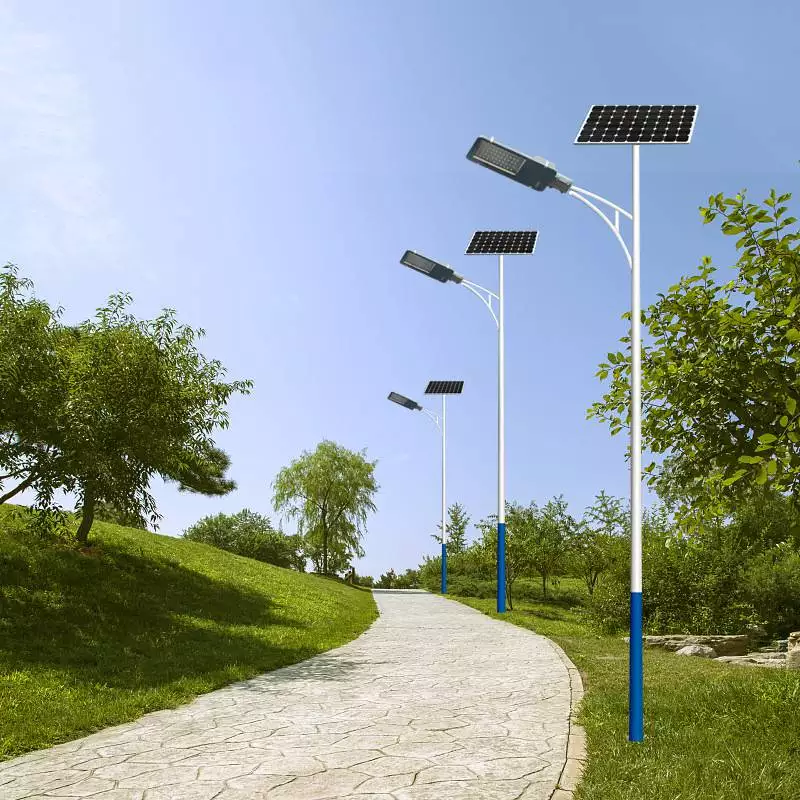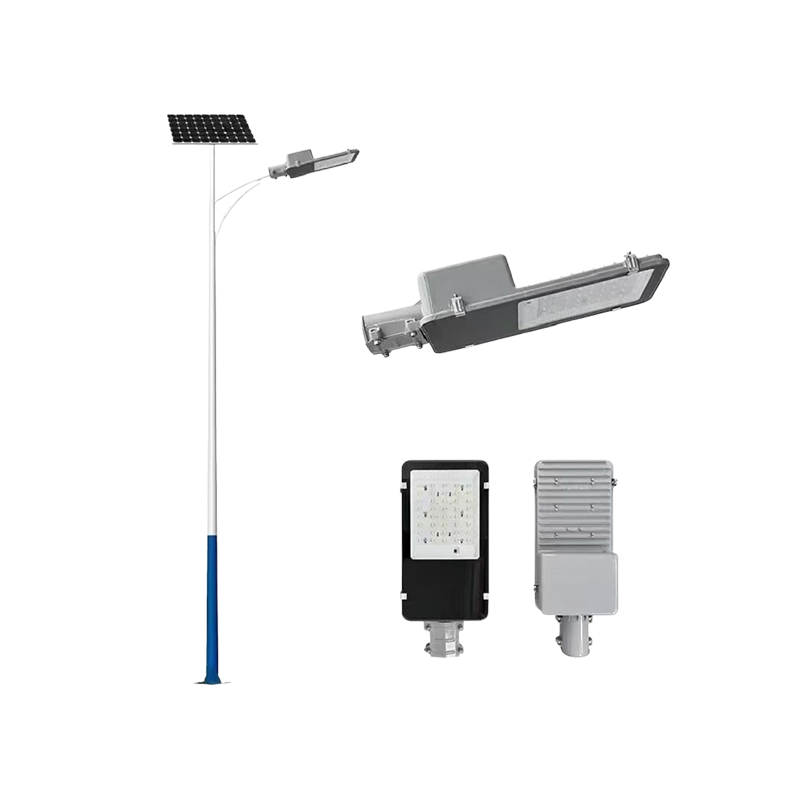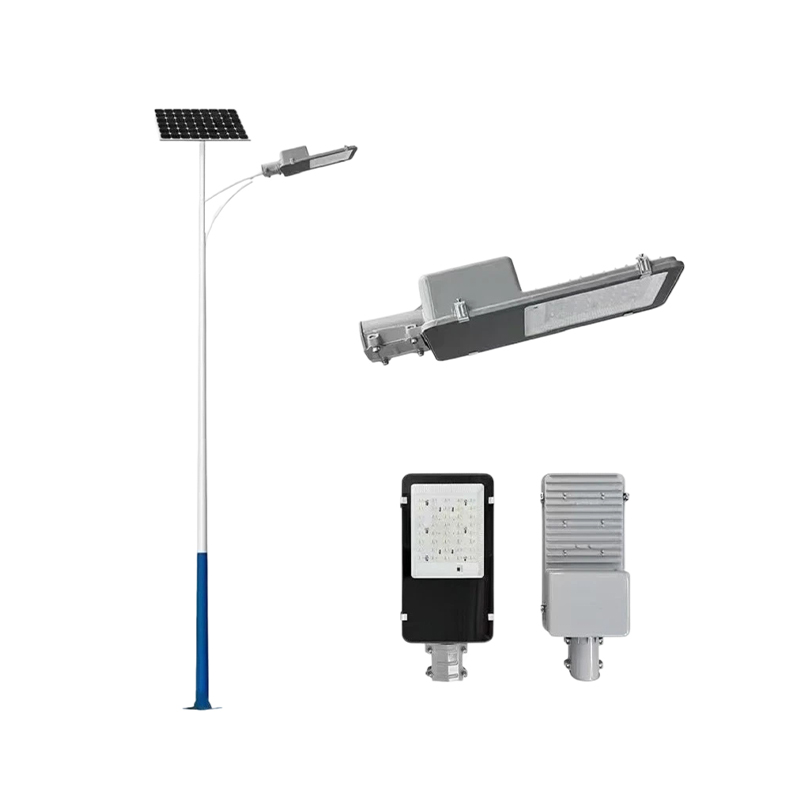Zero Electricity Bills, Zero Pollution: How Solar Street Lights Are Rewriting Urban Lighting History?
Release Time : 2025-10-28
——Reshaping the Future of Green Lighting with Innovative Technology
As the global energy transition and "dual carbon" goals drive progress, urban lighting is undergoing a quiet revolution. Traditional streetlights, reliant on grid power, not only consume vast amounts of fossil energy but also face challenges like complex wiring and high maintenance costs. In contrast, solar street lights, with their core advantages of "zero electricity bills, zero pollution", combined with high-strength structures, efficient energy storage, and intelligent controls, are gradually rewriting the history of urban lighting. This article analyzes the technical highlights and application value of a typical solar street light model.

1. Structural Innovation: Q235 Steel + One-Piece Tapered Pole for a "Robust Framework"
Traditional streetlight poles are prone to corrosion and deformation, posing safety risks. This solar street light adopts Q235 carbon structural steel and is manufactured using a one-piece tapered pole process, boosting pole strength by over 30% and enabling resistance to 12-level typhoons and extreme weather. After hot-dip galvanizing, the pole is coated with outdoor anti-rust paint, forming a dual-layer protective barrier. This extends its service life to over 15 years, significantly reducing long-term maintenance costs.
Technical Value:
Corrosion resistance increased by 5 times, adaptable to coastal and high-humidity environments;
One-piece molding eliminates welding gaps, preventing safety hazards caused by structural loosening.
2. Lighting Upgrade: IP65 Waterproof LED Head for Efficient, Eco-Friendly Illumination
The core of any streetlight is its lighting quality. This model uses high-brightness LED light sources with a luminous efficacy of 160 lm/W, saving 60% more energy than traditional sodium lamps. The LED head is IP65-rated, offering complete dustproofing and resistance to low-pressure water jets, ensuring stable operation during heavy rain or sandstorms.
Technical Highlights:
Color Rendering Index (Ra) ≥ 70, approaching natural light to enhance nighttime driving and pedestrian safety;
Smart dimming supports light-sensing control, preventing energy waste from over-illumination.

3. Energy Storage Breakthrough: Lithium Iron Phosphate Batteries for 5-7 Years of Reliability
The energy storage system is the "heart" of solar street lights. This product uses lithium iron phosphate (LiFePO₄) batteries, which offer over 2,000 charge cycles and a lifespan of 5-7 years at 25°C—three times longer than traditional lead-acid batteries. Equipped with a Battery Management System (BMS), the battery monitors voltage and temperature in real time to prevent overcharging/discharging, ensuring safety.
Comparative Advantages:
Energy density 1.5 times higher than lead-acid batteries, with a smaller, lighter design;
Excellent high-temperature performance (-20°C to 60°C wide operating range), suitable for diverse climates.
4. Photovoltaic Efficiency: 18%+ Conversion Rate Solar Panels to Capture Every Ray of Sunlight
Solar panel efficiency directly determines charging capacity. This model features monocrystalline silicon solar panels with a conversion rate exceeding 18% (industry average: 15%-17%), enabling continuous battery charging even in cloudy or low-light conditions. The panel surface is coated with a self-cleaning layer to reduce dust accumulation and maintain long-term efficiency.
Data Support:
Daily effective charging time extended by 2 hours, with rainy-day endurance improved by 40%;
Power degradation ≤ 20% over 20 years, far outperforming the 30% degradation of standard panels.
5. Intelligent Control: Light Sensing + Timing for "On-Demand Lighting"
Traditional streetlights require manual timing adjustments, whereas this solar street light integrates light-sensing + timing dual modes:
Light-Sensing Activation: Automatically turns on at dusk and off at dawn;
Timing Adjustment: Supports 1-12 hours of customizable lighting duration (default: 6 hours) for diverse scenarios;
Energy-Saving Strategy: Reduces brightness to 50% after midnight to further cut energy use.
Application Scenarios:
Urban roads: Meets basic lighting needs while reducing light pollution;
Rural and remote areas: Plug-and-play installation solves lighting challenges in off-grid regions;
Parks and scenic spots: Combines energy efficiency with aesthetic nighttime landscapes.

6. Rewriting Urban Lighting History: From "Energy Giants" to "Zero-Carbon Benchmarks"
Statistics show that a traditional high-pressure sodium lamp (250W) consumes approximately 900 kWh annually, while an equivalent solar street light (60W LED + solar system) consumes nearly zero electricity (only ~5 kWh for battery self-discharge). For a mid-sized city with 100,000 streetlights, a full replacement could reduce annual CO₂ emissions by 80,000 metric tons, equivalent to planting 4.4 million trees.
Economic Analysis:
Initial investment is 30% higher than traditional streetlights but recoups costs within 5 years;
Total lifecycle costs drop by 55% over 10 years, with no electricity expenses.
The Future of Green Lighting Has Arrived
Solar street lights represent not just technological iteration but a cornerstone of urban sustainable development. From the robust Q235 steel framework to the long-lasting lithium iron phosphate battery "heart" and the intelligent control "brain," every breakthrough propels the lighting industry toward greater efficiency and environmental friendliness. As night falls, these self-sufficient solar streetlights illuminate not only roads but also a path toward a zero-carbon future.
As the global energy transition and "dual carbon" goals drive progress, urban lighting is undergoing a quiet revolution. Traditional streetlights, reliant on grid power, not only consume vast amounts of fossil energy but also face challenges like complex wiring and high maintenance costs. In contrast, solar street lights, with their core advantages of "zero electricity bills, zero pollution", combined with high-strength structures, efficient energy storage, and intelligent controls, are gradually rewriting the history of urban lighting. This article analyzes the technical highlights and application value of a typical solar street light model.

1. Structural Innovation: Q235 Steel + One-Piece Tapered Pole for a "Robust Framework"
Traditional streetlight poles are prone to corrosion and deformation, posing safety risks. This solar street light adopts Q235 carbon structural steel and is manufactured using a one-piece tapered pole process, boosting pole strength by over 30% and enabling resistance to 12-level typhoons and extreme weather. After hot-dip galvanizing, the pole is coated with outdoor anti-rust paint, forming a dual-layer protective barrier. This extends its service life to over 15 years, significantly reducing long-term maintenance costs.
Technical Value:
Corrosion resistance increased by 5 times, adaptable to coastal and high-humidity environments;
One-piece molding eliminates welding gaps, preventing safety hazards caused by structural loosening.
2. Lighting Upgrade: IP65 Waterproof LED Head for Efficient, Eco-Friendly Illumination
The core of any streetlight is its lighting quality. This model uses high-brightness LED light sources with a luminous efficacy of 160 lm/W, saving 60% more energy than traditional sodium lamps. The LED head is IP65-rated, offering complete dustproofing and resistance to low-pressure water jets, ensuring stable operation during heavy rain or sandstorms.
Technical Highlights:
Color Rendering Index (Ra) ≥ 70, approaching natural light to enhance nighttime driving and pedestrian safety;
Smart dimming supports light-sensing control, preventing energy waste from over-illumination.

3. Energy Storage Breakthrough: Lithium Iron Phosphate Batteries for 5-7 Years of Reliability
The energy storage system is the "heart" of solar street lights. This product uses lithium iron phosphate (LiFePO₄) batteries, which offer over 2,000 charge cycles and a lifespan of 5-7 years at 25°C—three times longer than traditional lead-acid batteries. Equipped with a Battery Management System (BMS), the battery monitors voltage and temperature in real time to prevent overcharging/discharging, ensuring safety.
Comparative Advantages:
Energy density 1.5 times higher than lead-acid batteries, with a smaller, lighter design;
Excellent high-temperature performance (-20°C to 60°C wide operating range), suitable for diverse climates.
4. Photovoltaic Efficiency: 18%+ Conversion Rate Solar Panels to Capture Every Ray of Sunlight
Solar panel efficiency directly determines charging capacity. This model features monocrystalline silicon solar panels with a conversion rate exceeding 18% (industry average: 15%-17%), enabling continuous battery charging even in cloudy or low-light conditions. The panel surface is coated with a self-cleaning layer to reduce dust accumulation and maintain long-term efficiency.
Data Support:
Daily effective charging time extended by 2 hours, with rainy-day endurance improved by 40%;
Power degradation ≤ 20% over 20 years, far outperforming the 30% degradation of standard panels.
5. Intelligent Control: Light Sensing + Timing for "On-Demand Lighting"
Traditional streetlights require manual timing adjustments, whereas this solar street light integrates light-sensing + timing dual modes:
Light-Sensing Activation: Automatically turns on at dusk and off at dawn;
Timing Adjustment: Supports 1-12 hours of customizable lighting duration (default: 6 hours) for diverse scenarios;
Energy-Saving Strategy: Reduces brightness to 50% after midnight to further cut energy use.
Application Scenarios:
Urban roads: Meets basic lighting needs while reducing light pollution;
Rural and remote areas: Plug-and-play installation solves lighting challenges in off-grid regions;
Parks and scenic spots: Combines energy efficiency with aesthetic nighttime landscapes.

6. Rewriting Urban Lighting History: From "Energy Giants" to "Zero-Carbon Benchmarks"
Statistics show that a traditional high-pressure sodium lamp (250W) consumes approximately 900 kWh annually, while an equivalent solar street light (60W LED + solar system) consumes nearly zero electricity (only ~5 kWh for battery self-discharge). For a mid-sized city with 100,000 streetlights, a full replacement could reduce annual CO₂ emissions by 80,000 metric tons, equivalent to planting 4.4 million trees.
Economic Analysis:
Initial investment is 30% higher than traditional streetlights but recoups costs within 5 years;
Total lifecycle costs drop by 55% over 10 years, with no electricity expenses.
The Future of Green Lighting Has Arrived
Solar street lights represent not just technological iteration but a cornerstone of urban sustainable development. From the robust Q235 steel framework to the long-lasting lithium iron phosphate battery "heart" and the intelligent control "brain," every breakthrough propels the lighting industry toward greater efficiency and environmental friendliness. As night falls, these self-sufficient solar streetlights illuminate not only roads but also a path toward a zero-carbon future.







